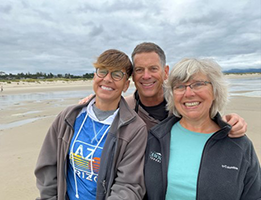09/02/2022

Til Luchau of Advanced Trainings joined me in real space, and we took advantage of that opportunity to record an I Have a Client Who story regarding a person (Til’s wife, in fact) who has chronic sciatic pain that has never fully resolved, despite receiving the finest manual therapy available.
We discuss what happens when all our best skills don’t get the results we hope for, and what it means to redefine goals for chronic pain conditions to improve levels of function and quality of life.
Resources:
Pocket Pathology: https://www.abmp.com/abmp-pocket-pathology-app
Straight Leg Raise: https://commons.wikimedia.org/wiki/File:Exercise_Straight_Leg_Raises.png



Books of Discovery: www.booksofdiscovery.com
Advanced-Trainings: www.advanced-trainings.com
About Til Luchau and Advanced-Trainings.com:
As a Certified Advanced Rolfer™, Til was on the faculty of the Dr. Ida Rolf Institute® for 20 years, where he served as Coordinator and Faculty Chair of the Foundations of Rolfing Structural Integration program. The author of the Advanced Myofascial Techniques textbook series (which has been translated into six languages), his regular “Myofascial Techniques” and “Somatic Edge” columns have been featured in Massage & Bodywork magazine since 2009, and (along with Whitney Lowe) he co-hosts the popular Thinking Practitioner Podcast. He is the director of Advanced-Trainings.com, which since 1985 has offered short, credit-approved professional trainings and certification for manual therapists of all types, in person and online.
Website: Advanced-Trainings.com
Email: info@advanced-trainings.com
Facebook: facebook.com/Advanced.Trainings1/
Instagram: instagram.com/tilluchau
YouTube: youtube.com/user/AdvancedTrainings
[music]
0:00:00.0 S?: Til Luchau is pleased to invite you to two amazing opportunities. Come to Til's popular hands on sciatica training as it makes its Zoom debut on August 12th. Get a full day of personalized tutoring, camera on supervision and permanent recordings and CE credit all at an amazing price. Til's new A-T subscription gives unlimited access to a growing catalog of over 35 curated advanced myofascial techniques, Feldenkrais and Zoga movement classes for body workers for as little as $20 per month. Sign up now at advanced-trainings.com.
[music]
0:00:47.8 Ruth Werner: Hey I Have a Client Who listeners. Did you know I have a growing library of NCB approved, one hour online, self-paced continuing education courses that you can do anytime, anywhere? Well, now you know. Current classes include, What's Next COVID-19 updates for massage therapists and a massage therapist introduction to pharmacology part one, and brand new, a massage therapists introduction to pharmacology part two. Classes are $20 each and they confer one hour of continuing education credit. Wanna know more? Visit my website at ruthwerner.com and check it out. Be sure to sign up for my mailing list so you'll never miss a new class.
[music]
0:01:42.0 RW: Hi, and welcome to I Have a Client Who, Pathology Conversations with Ruth Werner. The podcast where I will discuss your real life stories about clients with conditions that are perplexing or confusing. I am Ruth Werner, author of A Massage Therapist Guide to Pathology, and I have spent decades studying, writing about and teaching about where massage therapy intersects with diseases and conditions that might limit our client's health. We almost always have something good to offer even with our most challenged clients, but we need to figure out a way to do that safely, effectively and within our scope of practice. And sometimes, as we have all learned, that is harder than it looks.
0:02:28.8 RW: I Have a Client Who listeners, we have a special treat this week. Once again, you might find that the sound is a little different from what you're used to, that's because we are recording this in the beautiful camper of Til Luchau. But what we have discovered is that we can hear birds and squirrels and passing cars and leaf blowers and any number of other things. I apologize if that's annoying, but it's sort of all part of the ambience of our working together.
0:03:00.5 Til Luchau: In your driveway.
0:03:00.7 RW: In my driveway. I'm very honored to have Til visiting. And we thought we'd take advantage of this opportunity to have Til share an I Have a Client Who story, and I have already promised to push back and dig in a little bit. Here we go.
0:03:14.5 TL: Right on.
0:03:15.2 RW: Til, tell me your I Have a Client Who story.
0:03:18.0 TL: Well, it's good to be here. And I am on my way to Portland to teach a sciatica class, both there and online. And I thought, what better topic to talk about than sciatica. And my favorite sciatica client, who is my lovely wife, Loretta.
0:03:38.8 RW: Alright. Before we go further, I would like to know how you define sciatica.
0:03:45.3 TL: Yes. Sciatica is one of those symptoms rather than a condition, where it's defined by what people feel. And typically, people feel a pain in the buttock or lower back or back of the leg. It can extend down lower all the way to the big toe. But that's the defining characteristic. Sometimes tingling, the quality pain is important too, it's the electric, probably it's assumed to be nerve type of a sensation.
0:04:12.6 RW: I heard someone once describe it as a dentist drilling all the way down their leg.
0:04:16.4 TL: Yeah. Right.
0:04:17.9 RW: Alright. We have nerve pain down the leg?
0:04:20.4 TL: Yeah.
0:04:21.0 RW: But encaptured then within your definition of sciatica, you are not identifying a source or cause of this pain?
0:04:29.0 TL: In the diagnosis or the label doesn't include that 'cause there's many things that can cause it. Of course, this particular client over the years has been on a hunt for what might be causing it.
0:04:42.0 RW: Yeah. Let's tell... Let's hear about your work with Loretta.
0:04:44.8 TL: Yeah.
0:04:45.8 RW: By the way, listeners, I usually don't give away identifying information, but this is a little bit of a special case.
0:04:51.6 TL: Special case. She is a special case. [laughter] She's been a wonderful learning partner over the years. She's a body worker herself and so a lot of these puzzles are participatory with her. Yeah, sciatic pain, it seems to be exacerbated by more lordosis. I get a positive straight leg test, meaning it hurts when she raises her straight leg.
0:05:16.5 RW: When you raise her straight leg?
0:05:17.9 TL: Either.
0:05:18.1 RW: Okay.
0:05:18.5 TL: I raise it or she does. It's not as clear what happens when she slumps her head, which is another variation on that test, but the straight leg raise will increase the sensation that she gets done inside.
0:05:33.0 RW: And what have you been doing with her?
0:05:35.4 TL: We've done so many things over the years. And the interesting thing is they all help, but we've had to redefine our goals over the years because it's a persistent symptom. Maybe it's a stage of life thing, but it used to be, "Let's just fix this. Let's get rid of this. I know a bunch about sciatica. I can do that." I thought. And...
0:05:54.0 RW: Oh, that's very humbling then, to think you can walk into a situation, especially with a loved one, and say, "Oh yeah, I got this." And then you don't got it.
0:06:03.0 TL: Well, it would go away and then it would come back. Or I'd improve it and then it would reappear.
0:06:07.8 RW: Wow! That's interesting. And how long ago did this begin?
0:06:13.7 TL: Let's say 20 something years.
0:06:17.0 RW: And, I'm trying to think of the kinds of questions that listeners might be interested to know. What kinds of activities make it worse?
0:06:24.3 TL: Arching back, more lordosis.
0:06:26.9 RW: Right, arching her back.
0:06:28.0 TL: Walking in certain ways, like walking downhill, I remember right, walking in certain shoes will exacerbate it.
0:06:38.4 RW: I was gonna ask if you've played with footwear?
0:06:40.8 TL: Oh, yeah.
0:06:41.0 RW: Yeah.
0:06:41.8 TL: And there were various times when bare foot or minimalist footwear could improve it a lot and other times that would seem to exacerbate it. It's...
0:06:48.7 RW: That's just not fair.
0:06:50.0 TL: I know. You think you'd figured out and it's like... [laughter] You got it unlocked and then it changes or something else happens.
0:06:55.9 RW: Does the quality of how she talks about her pain, does she describe it any differently as time has gone on or is it always, It's that one.
0:07:04.9 TL: I love that question. 'Cause there's... I get so much from listening to people describe their pain. I get so much information not only so I can kind of deduce in a rational way what might be going on, but so that I can get a mood or feeling for the pain itself and know how to work with it. Yeah, it'll be... That's a good question you'd have to think. Over the years, has it changed for her? It'll change moment by moment. Sometimes it's just exhausting, exasperating. Other times it's mildly annoying. And all of those things will come through in the quality of her description, her voice for sure.
0:07:39.9 RW: Right. Right. Have you ever had it... Alright, Let's go back to... Let's talk now about diagnosis.
0:07:46.0 TL: Yeah.
0:07:46.7 RW: Right? Do you wanna give me your short list of things that can cause sciatic pain?
0:07:51.0 TL: It's a topic I've been teaching on for many years and I gotta say the more I teach about it... What can I say, the less certain I am about any of these maps we use, but the map is basically, the simplest map is it's either appendicular or axial. The place that the nerve is being either irritated or compressed.
0:08:12.4 RW: Right. Something happening in the spinal cord or something happening in the leg?
0:08:16.3 TL: Something happening near the spinal cord, with the nerve roots. Or something happening in the periphery which could be hip or leg or... And with her, that straight leg raise I'd mentioned which is, I won't try to describe it here, but it's a pretty standard orthopedic test.
0:08:30.8 RW: Mostly it'll be easy to look it up and I can put a link.
0:08:33.7 TL: Yeah, great. That's thought to be pretty indicative of radicular pain, pain involving the nerve roots. If you can make the pain happen by raising the straight leg, that's thought to be the nerve roots. Here's the...
0:08:47.0 RW: As opposed to something like a bone spur or a disc?
0:08:49.6 TL: As opposed to... No, a disc or bone spur could impinge on nerve roots.
0:08:54.8 RW: Yeah.
0:08:54.9 TL: Those could be mechanisms of nerve root irritation.
0:08:57.0 RW: Alright, alright, okay. The nerve root... We're taking the nerve root all the way back up into the...
0:09:01.0 TL: Dorsal horn, right into the...
0:09:02.8 RW: In... Yeah, into the foramen.
0:09:04.8 TL: Foramen, where it's supposed to...
0:09:04.9 RW: Okay, as opposed to a disc or tumor or something in the cauda equina in this case that's putting pressure in there? Right. This is all unilateral?
0:09:16.3 TL: Unilateral.
0:09:17.4 RW: And?
0:09:18.9 TL: Key question.
0:09:19.6 RW: Yeah. And what have you learned as you... I imagine she has pursued this with an orthopedist, a neurologist, a whoever, what have you learned that the medical community suggests or is thought as a cause?
0:09:37.0 TL: Yeah. The... She hasn't done all of what you said, but she has gotten conventional medical opinions about it, and they ascribe it to the result of some spondylolisthesis, a little bit of movement between the vertebrae, narrowing the frame in there.
0:09:53.5 RW: I have that. [laughter]
0:09:54.6 TL: Yes. Many people do. And of course, the controversy is not everybody who has an MRI has that pain. And it's not necessarily an inevitability that you'll have that pain, but when you see pain and you see that, it's a possibility.
0:10:07.7 RW: And there's nothing else that is obviously another front runner for a contributor.
0:10:16.0 TL: There... And it's also been part of my general interest in inflammation, because if other inflammatory contributors are online, that sciatic pain will be worse.
0:10:25.8 RW: Yeah, that's an interesting... We could go all kinds of different directions. The other word that we haven't said yet in this context is piriformis, and of course that would be a radicular as opposed to axial source.
0:10:39.0 TL: Appendicular, yeah.
0:10:40.0 RW: I'm sorry. Appendicular, yeah.
0:10:42.0 TL: Absolutely.
0:10:43.0 RW: And you've looked at them. I imagine you have pursued that to the best of your ability?
0:10:47.5 TL: Yep. I sure have. And in fact, with a lot of other clients I've learned over the years, there's so many things that can contribute besides just the piriformis. We call it either piriformis or spinal, but there's so many things along that pathway, but it's none of those. It's pretty clearly the nerve root.
0:11:03.3 RW: And what do you... You're lucky that [laughter] this is a client who was probably gonna continue to see you.
0:11:10.7 TL: Yeah, she's stuck with me. [laughter]
0:11:13.9 RW: If this were someone who was a regular paying client kind of person, would you give up on them? Would you...
0:11:24.9 TL: [laughter] Fire them.
0:11:25.0 RW: Try to work with them? Would you...
0:11:26.0 TL: Charge them double.
0:11:27.2 RW: No. [laughter] Refer them out.
0:11:30.1 TL: That's right.
0:11:31.0 RW: Because what you're discovering is that...
0:11:32.9 TL: No...
0:11:33.1 RW: What you're doing seems to work sometimes for a while, but you're not coming up with a...
0:11:38.0 TL: Well...
0:11:38.7 RW: Long-term...
0:11:39.0 TL: What I described was a reframe for us both about our goal. And working initially to try to fix it, get rid of it once and for all, and then realizing we could improve it, but that whatever contributors were irritating it were still there over time. And then digging the next layer of those, it's... The reframe was, can we help you live with this? Can we help you be comfortable enough to do what you wanna do and find ways to manage it yourself even? And that's been really fruitful as well.
0:12:10.0 RW: Oh, good. That has yielded some benefits for you?
0:12:14.0 TL: Huge, I would say, huge improvement in a function and physical activity levels. And it still hurts.
0:12:21.9 RW: Yeah.
0:12:22.3 TL: And yet...
0:12:23.0 RW: But the pain becomes less important?
0:12:24.9 TL: Yeah. I guess, it becomes less of a barrier.
0:12:27.0 RW: Right.
0:12:27.7 TL: Yeah.
0:12:28.0 RW: And that is exactly why I asked you that question. Because that idea of reframing a realistic expectation is something that a lot of people who live with chronic pain have to come to grips with and people who, like us, who are trying to help people live with chronic pain also need to acknowledge. It's not a failure if it's not fixed.
0:12:50.6 TL: Right. Even though we want to. Even though our client wants us to, so many of those things are about understanding how to experience in a different way, do things differently, how it means something different to us.
0:13:04.0 RW: And find the manual therapies that are as helpful as possible.
0:13:07.3 TL: Do whatever we can.
0:13:08.9 RW: Yeah.
0:13:09.0 TL: And including things for ourselves. Like I said, movement for her has been really key.
0:13:13.0 RW: Great. Well, thank you for sharing that very personal story.
0:13:16.9 TL: Yeah.
0:13:17.9 RW: I will put information in the show notes about where people can find you and get more information about your educational opportunities.
0:13:27.0 TL: Always appreciated.
0:13:28.0 RW: Yeah, and thank you so much for visiting me out here, it's been lovely to have you.
0:13:33.0 TL: It's been great to be here and thanks for the... All that you do for our profession, and all the things you teach us, and the things that you share with us. It helps us all. Thank you.
0:13:40.0 RW: Thank you, Til. Hey everybody, thanks for listening to, "I Have a Client Who... " pathology conversations with Ruth Werner. Remember, you can send me your, "I Have a Client Who... " stories to ihaveaclientwho@abmp.com. That's I have a client who, all one word, all lowercase, at A-B-M-P dot com. I can't wait to see what you send me, and I'll see you next time.
[music]





